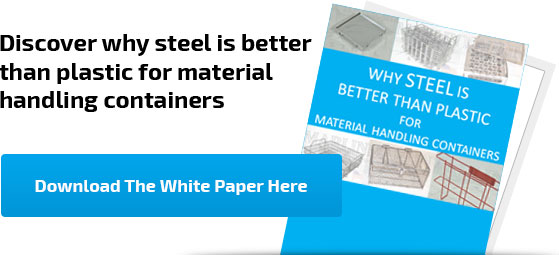A while back, the National Association of Manufacturers produced a video about how “cool stuff is being made” here at Marlin Steel. Throughout the video, which you can find attached below, you get to see how it is that Marlin Steel makes high-quality custom steel wire baskets for a variety of industries, including:
- Aerospace companies
- Automotive parts manufacturers
- Munitions companies
- Pharmaceutical product manufacturers
These industries demand a high level of precision in the manufacture of their products. The stainless steel wire baskets they use have to withstand physically punishing parts finishing processes day in and day out while protecting the parts held within.
So, how is a high-quality custom parts washing basket made?
In the video, you can see how a steel wire basket production process from beginning to end, here are some highlights from the video:
Step 1: Design
Before assembly can possibly begin, a custom steel wire basket’s design needs to be created, vetted, and finalized.
Marlin Steel’s design engineers begin by getting a detailed briefing on the fit, form, and function of the parts and the parts finishing processes the basket will be used with. Clients fill out a questionnaire that asks for numerous details about the process so that the design engineers can choose the best materials and other design elements for the job.
The design is tested virtually using physics simulation software, and a print of the design is sent to the client for approval. This design process is the “secret sauce” that Marlin uses to stay ahead of competitors by saving time and money on wasteful physical prototyping.
Step 2: Go, No Go, Check Fixture
Once the design print is approved, the print is downloaded to a specialized computer that creates a mold, or a “go, no go” fixture. This fixture design is then downloaded onto a wood router machine.
The wood router has a spindle that rotates at 20,000 RPM, cutting slots into the wood fixtures that will hold basket wires as they are being welded together, ensuring consistent weld placement and wire angles in the final product. This helps to ensure that every part Marlin makes is uniform and will meet the same tolerances.
Step 3: Uncoiling Steel Wire
 Another step that takes place shortly after a design print is approved by the client is that Marlin Steel will place an order for one or more coils of steel wire to actually make the basket. This material will generally come from Philadelphia, Kentucky, or Chicago, depending on availability.
Another step that takes place shortly after a design print is approved by the client is that Marlin Steel will place an order for one or more coils of steel wire to actually make the basket. This material will generally come from Philadelphia, Kentucky, or Chicago, depending on availability.
These steel wire coils weigh more than a typical car, and come in several varieties:
- Plain Steel
- Stainless Steel
- Galvanized Steel
Plain steel typically gets used for general purpose materials handling containers where corrosion resistance is not a factor. Galvanized steel is often used in sheet metal applications for pipe bollard assemblies.
Stainless steel is the most frequently used material for parts finishing applications where corrosion resistance is a factor in the useful life of the basket. This material can be further broken down into hundreds of individual varieties, each one with different hardness, corrosion resistance, and temperature resistance characteristics.
A coil of steel is lifted via forklift and placed on a special wire straightening machine. The coil is fed into the machine, eliminating the curvature of the steel from being wrapped into a coil.
Step 4: Wire Bending
As the coil of steel comes out of the straightening machine, a specialized wire bending robot arm makes precise bends in the steel wire, permanently reshaping it to conform to the design the engineers created back in step one.
When a length of wire is completed, the bending robot cuts the wire and another robotic arm places it on a rack to be collected up for final assembly later.
This bending robot can make dozens of bends in a length of wire in mere moments, with greater accuracy and speed than what a worker handling the task manually can manage. Using a bending robot for this task also reduces the risk of workers getting injured, a common occurrence when manually shaping and cutting steel wires.
Step 5: Assembly
Using the pre-shaped lengths of steel wire and slotting them into the go/no go check fixtures, Marlin’s employees weld the steel wires together into a basket.
After the basket is assembled, it is put through a deburring process that removes any sharp edges that the machine cutting the wire may have left, as well as excessive discoloration from the welding process.
This leaves a clean, smooth basket surface so that parts placed in the basket are less likely to become scratched or otherwise damaged by contact with the basket.
Once the deburring is done, the baskets are packed for shipment to the client, which includes companies in the domestic U.S., Canada, China, or dozens of other countries.



.gif)


